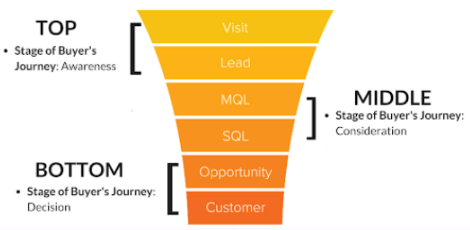If you’re off and running with inbound content marketing, then you’re probably already well aware that you need a lot of content.
And we mean ‘A Lot’.
Your inbound marketing funnel relies on it. The more content you produce, the fuller your funnel will become.
The problem (besides being able to produce a lot of content), is making sure that the content you produce is doing its job. Whatever each individual piece of content is designed to do, are they hitting the mark overall and filling your funnel with lead opportunities?
To help to make sure that your content does that, we had a think about the five most important inbound content marketing guidelines that would point you in the right direction. We think these are the key rules to make sure the inbound content you produce equates to opportunity in the funnel.
Starting with…
1. Consider leaving the gate open
Gated content – requiring the submissions of user data (i.e. their email address) to access – should still be a huge part of your marketing. Gated content is your lead generating mechanism when you have the right piece of content and target market, and it needs to continue to be.
But when it’s used incorrectly, gated content can trigger negative feelings towards your brand; even feelings of mistrust.
Gated content needs to be of real defined value to your users, offering them something that’s going to feel ‘worth’ the ‘price’ they’ve paid for it. The experience of getting access to the content also needs to be slick and in line with how the users expect to access content of it’s type.
This makes for a simple guideline: if gated content isn’t going to result in a positive experience for your user then consider ‘leaving the gate open’.
2. Have content available for every stage of your buyer journey (and every stage of your inbound marketing funnel)
This is a guideline that we think a lot of companies running inbound content marketing campaigns could benefit from following.
The natural tendency when you start to produce content is to produce for the awareness stage of a buyer journey, or the attract stage of the inbound methodology. And, quite often, that’s the right approach. Many companies’ inbound efforts struggle because of a lack of visitors at the top of their inbound marketing funnel (AKA TOFU).
The problem though can quickly change to the fact that there is no middle of the funnel (MOFU) or bottom of the funnel (BOFU) content to help buyers further on in their journey. Those who have reached the consideration and decision stages.
Buyers at these stages – likely to be marketing qualified leads (MQLs) and sales qualified leads (SQLs) in your funnel, or going through the close stage of the inbound marketing model – need very different content to those just becoming aware of your product.
Consideration (MOFU) and decision (BOFU) content can be more product or service focused, explaining how your offering works or the exact benefits of what you can offer.
These can also be the phases where some proof that your product or service works can also be useful. Case studies, possibly featuring social proof, can be a big help when you arrive at this point with buyers.
When you’re creating content then, make sure there’s a good mixture across all buying stages, otherwise you’ll end up with your funnel ‘getting stuck’, full of prospects who can’t move on to the next point and make a purchase. Consider the below easy reference guide to help with this.

Awareness stage content (TOFU)
Blogs that speak to people’s problems and help them to see that there are solutions available. ‘How do I…’ and ‘how can I…’ content tends to fit into the awareness stage very well. Also consider whitepapers, ebooks, checklists and tip sheets.
Consideration stage content (MOFU)
Consideration stage content needs to demonstrate to readers why you have the most viable solution available to the problem they’ve become aware of. Product sheets, demo videos, webinars, detailed case studies and FAQs are all good options.
Decision stage content (BOFU)
Consider this as ‘content that gets buyers over the line’. What can you do to convince your prospect that a purchase is in their best interests? Case studies and social proof can again be useful. Free trials/evaluations/assessments and live demonstrations, if appropriate, can also work. Consider leveraging a discount code to use at the time of the transaction to establish a sense of urgency around making the purchase.
3. Consider your sign-off process
It’s all too common for content marketing efforts to get entangled in unnecessary and long sign-off processes, particularly if this is the first time your company has tried its hand at properly producing content.
When thinking about who needs to sign off your content and how you’ll do it, bear in mind that content delayed through sign off represents missed opportunities. Your content can’t help you if it’s not ‘out there’.
The result of a thorough sign-off process might be that your content is a bit better. But the result of having that content three months earlier could be that your sales and marketing figures for the quarter look a lot better!
Which one of those results would you rather have?
To avoid either skipping sign off completely or the option of a lengthy sign off period, draw up a content process early on in your marketing efforts.
As part of the process get people in sign off roles to agree to timescales and when they will review work. Reviews after an early draft are perfect. Reviewing when something is ready and about to go live, only to make changes that stop it going live is… less than perfect.
4. Take risks
If you work in a popular and competitive sector then it’s likely that someone will have already written a lot of the obvious material.
That doesn’t mean you shouldn’t write on the same topic. Particularly if you need to hit certain keywords.
But it does mean that you should consider thinking outside the box and producing content that’s maybe a bit ‘out there’ or that covers a topic your company might not normally be expected to write on.
Content marketing, as a strategy is now a relatively mature one and taking risks with your content can be a good way to make sure you stand out and that your ongoing content production doesn’t become stale.
5. Whisper it, but… some of your content may need to ‘sell’
Inbound content marketing is about being helpful. It’s about getting the right content in front of the right people, when they need it most.
You will get more readers by saying: ‘this is how I can help to solve your problem’ than you will get by saying ‘I can solve your problem by selling you this’.
You should always make sure, as a general guideline, that your content is pitched with the aim of helping readers, rather than selling. Consider their pain points and offer a solution.
That said…
There are occasions when you will need more sales-focused content to fill your inbound marketing funnel.
Sales people, for example, may need product sheets, which emphasise the main benefits of your product to the user. You can still write those documents in a helpful, ‘inbound’ way, but ultimately they’re going to need to ‘sell’ your product or services at some point.
Really, the message of this guideline, which no doubt your sales people will tell you at some point soon, is: sales people need content too!
Put your content to work and fill your funnel
By following the above content marketing guidelines, you’ll soon be producing great content that fills your marketing funnel.
If you need help producing content, setting up HubSpot to work for you or just need a helping hand getting your inbound marketing strategy moving then we’re here to help. Click here to speak to an inbound specialist, we can often help you to get moving in the right direction on the first call.




